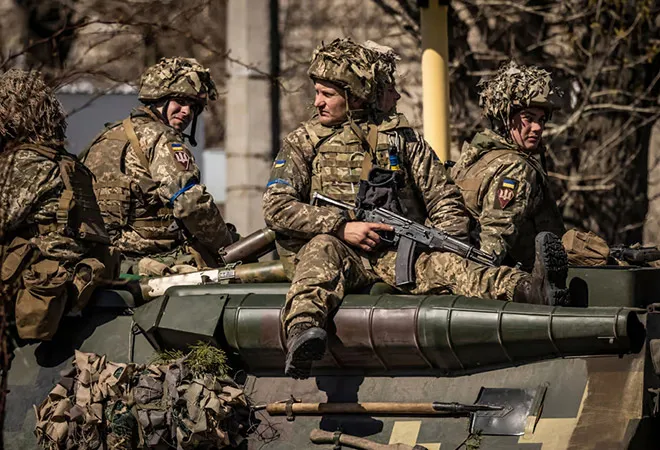
A
report released by Stockholm International Peace Research Institute (SIPRI) has found that of the world’s 100 largest arms suppliers, the output of the United States (US) companies remained flat with a marginal decline of 0.9 percent on year in 2021, while Europe (excluding Russia) registered a growth of 4.2 percent over the same period, albeit with significant disparities within the region. For instance, while the United Kingdom (UK) witnessed a sales decline of 2.7 percent, France’s arms sales grew a robust 15 percent on year to US$ 28.8 billion in 2021.
To place things in context, the total arms sales of the largest 100 suppliers grew by only 1.9 percent in 2021, over the pandemic-affected 2020. This makes it important to gauge the impact of the ongoing war in Ukraine on Western defence production, which will only reflect for the first time in arms sales data for 2022.
Labour shortages caused by travel restrictions were reported by multiple Western defence and aerospace original equipment manufacturers (OEM), as another major hindrance to production.
Pre-war obstacles to industry growth
In 2021, the effects of public health restrictions applied globally to prevent the transmission of COVID-19, persisted throughout the world economy and did not spare the arms industry. Supply chain issues, including interrupted worldwide shipping and semiconductor shortages, impacted the arms sales of numerous firms—more so in the West due to reliance on integrated and complex global supply chains, but also elsewhere—primarily due to loss or postponement of sales that were expected to be recorded in 2021.
Labour shortages caused by travel restrictions were reported by multiple Western defence and aerospace original equipment manufacturers (OEM), as another major hindrance to production. Further, decreased demand was also cited by some US firms as a salient cause of a significant decline in sales.
The Ukraine war
With
unrelenting Russian airstrikes having destroyed over half of Ukraine’s power grid, ordinary Ukrainians have begun to bear the brunt of
sub-zero winter temperatures. Deployment of inexpensive suicide drones has gained currency post the appointment of General Sergey Surovikin as the new commander-in-chief of all Russian forces in Ukraine, and greatly boosted their capacity to sustain bombardments for extended periods,
without straining their remaining stockpiles of cruise missiles and more sophisticated and expensive weaponry.
The West has supplied Ukraine with military hardware and financial assistance since the outset of the war.
In response, Western sanctions imposed on Moscow have reached unparalleled levels, despite having to play
catch up with Russia’s wartime economy. The West has supplied Ukraine with military hardware and financial assistance since the outset of the war. With the North Atlantic Treaty Organization (NATO) faced with tangible weapons shortages and rapidly
declining stockpiles, however, the protracted conflict has exposed the
limits to the West’s arms production capacity due to the inability to reactivate inoperative manufacturing lines promptly and seamlessly, let alone establish new ones.
Outlook
With
no peace talks and no end in sight to the Ukraine war, efforts to aid Kyiv by increasing weapons production and replenishing depleted stockpiles are being coordinated by the Ukraine Defence Contact Group, a US-led grouping of more than 50 nations and organisations.
Contact group members are also helping train Ukrainian service members in the use of these capabilities, and numerous countries are now seeking avenues to assist Ukraine in defending itself over a longer duration.
However, boosting defence manufacturing requires time, sustained investments, and concerted effort. Hence, it may take many years for arms manufacturers to augment production capacity in light of the increased demand for munitions generated by the war, as demonstrated by the US’s order for
Javelin anti-tank guided missiles driven by the consumption of
five years’ worth of Javelin production by Ukrainian forces since the onset of fighting in late February.
Contact group members are also helping train Ukrainian service members in the use of these capabilities, and numerous countries are now seeking avenues to assist Ukraine in defending itself over a longer duration.
Weapons manufacturers in Europe are also expecting a considerable increase in demand for military hardware, projected on the basis of the requirement to replenish stockpiles of munitions and platforms supplied to Kyiv. In fact, Eastern Europe’s defence industry is producing artillery rounds, guns, and other military wares at a rate not achieved since the Cold War. However, commitments to continue supplying weapons to Ukraine for “
as long as it takes” are likely to eventually prove untenable.
Views expressed are personal.
The views expressed above belong to the author(s). ORF research and analyses now available on Telegram! Click here to access our curated content — blogs, longforms and interviews.



 A
A  PREV
PREV


